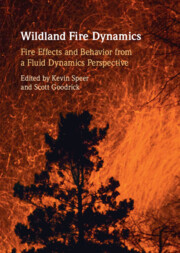Refine search
Actions for selected content:
8126 results in Fluid dynamics and solid mechanics
Index
-
- Book:
- Wildland Fire Dynamics
- Published online:
- 16 June 2022
- Print publication:
- 30 June 2022, pp 250-252
-
- Chapter
- Export citation
Contributors
-
- Book:
- Wildland Fire Dynamics
- Published online:
- 16 June 2022
- Print publication:
- 30 June 2022, pp viii-x
-
- Chapter
- Export citation
3 - Energy Transport and Measurements in Wildland and Prescribed Fires
-
-
- Book:
- Wildland Fire Dynamics
- Published online:
- 16 June 2022
- Print publication:
- 30 June 2022, pp 63-76
-
- Chapter
- Export citation
AN ANALYTICAL APPROXIMATION FOR CONVERTIBLE BONDS
- Part of
-
- Journal:
- The ANZIAM Journal / Volume 64 / Issue 2 / April 2022
- Published online by Cambridge University Press:
- 20 June 2022, pp. 135-148
-
- Article
- Export citation

Wildland Fire Dynamics
-
- Published online:
- 16 June 2022
- Print publication:
- 30 June 2022
Part I - Attractors for the Semigroups of Operators: An Abstract Framework
-
- Book:
- Attractors for Semigroups and Evolution Equations
- Published online:
- 19 May 2022
- Print publication:
- 09 June 2022, pp 1-2
-
- Chapter
- Export citation
4 - On dimensions of compact invariant sets
- from Part I - Attractors for the Semigroups of Operators: An Abstract Framework
-
- Book:
- Attractors for Semigroups and Evolution Equations
- Published online:
- 19 May 2022
- Print publication:
- 09 June 2022, pp 15-30
-
- Chapter
- Export citation
1 - Basic notions
- from Part I - Attractors for the Semigroups of Operators: An Abstract Framework
-
- Book:
- Attractors for Semigroups and Evolution Equations
- Published online:
- 19 May 2022
- Print publication:
- 09 June 2022, pp 3-5
-
- Chapter
-
- You have access
- Export citation
Index
-
- Book:
- Attractors for Semigroups and Evolution Equations
- Published online:
- 19 May 2022
- Print publication:
- 09 June 2022, pp 68-68
-
- Chapter
- Export citation
Contents
-
- Book:
- Attractors for Semigroups and Evolution Equations
- Published online:
- 19 May 2022
- Print publication:
- 09 June 2022, pp v-vi
-
- Chapter
- Export citation
Frontmatter
-
- Book:
- Attractors for Semigroups and Evolution Equations
- Published online:
- 19 May 2022
- Print publication:
- 09 June 2022, pp i-iv
-
- Chapter
- Export citation
Preface
-
- Book:
- Attractors for Semigroups and Evolution Equations
- Published online:
- 19 May 2022
- Print publication:
- 09 June 2022, pp xxvii-xxviii
-
- Chapter
- Export citation
Introduction
-
- Book:
- Attractors for Semigroups and Evolution Equations
- Published online:
- 19 May 2022
- Print publication:
- 09 June 2022, pp vii-xxvi
-
- Chapter
- Export citation
2 - Semigroups of class K
- from Part I - Attractors for the Semigroups of Operators: An Abstract Framework
-
- Book:
- Attractors for Semigroups and Evolution Equations
- Published online:
- 19 May 2022
- Print publication:
- 09 June 2022, pp 6-10
-
- Chapter
- Export citation
6 - Estimates for the number of determining modes and the fractal dimension of bounded invariant sets for the Navier–Stokes equations
- from Part II - Semigroups Generated by Evolution Equations
-
- Book:
- Attractors for Semigroups and Evolution Equations
- Published online:
- 19 May 2022
- Print publication:
- 09 June 2022, pp 35-38
-
- Chapter
- Export citation
5 - Introduction to Part II
- from Part II - Semigroups Generated by Evolution Equations
-
- Book:
- Attractors for Semigroups and Evolution Equations
- Published online:
- 19 May 2022
- Print publication:
- 09 June 2022, pp 33-34
-
- Chapter
- Export citation
3 - Semigroups of class AK
- from Part I - Attractors for the Semigroups of Operators: An Abstract Framework
-
- Book:
- Attractors for Semigroups and Evolution Equations
- Published online:
- 19 May 2022
- Print publication:
- 09 June 2022, pp 11-13
-
- Chapter
- Export citation
7 - Evolution equations of hyperbolic type
- from Part II - Semigroups Generated by Evolution Equations
-
- Book:
- Attractors for Semigroups and Evolution Equations
- Published online:
- 19 May 2022
- Print publication:
- 09 June 2022, pp 39-65
-
- Chapter
- Export citation
References
-
- Book:
- Attractors for Semigroups and Evolution Equations
- Published online:
- 19 May 2022
- Print publication:
- 09 June 2022, pp 66-67
-
- Chapter
- Export citation
Afterword
- from Part I - Attractors for the Semigroups of Operators: An Abstract Framework
-
- Book:
- Attractors for Semigroups and Evolution Equations
- Published online:
- 19 May 2022
- Print publication:
- 09 June 2022, pp 14-14
-
- Chapter
- Export citation
